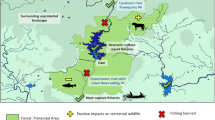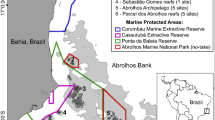Abstract
Loss of fish habitat in North America has occurred at an unprecedented rate through the last century. In response, the Canadian Parliament enacted the habitat provisions of the Fisheries Act. Under these provisions, a “harmful alteration, disruption, or destruction to fish habitat” (HADD) cannot occur unless authorised by Fisheries and Oceans Canada (DFO), with legally binding compensatory habitat to offset the HADD. The guiding principle to DFO’s conservation goal is “no net loss of the productive capacity of fish habitats” (NNL). However, performance in achieving NNL has never been evaluated on a national scale. We investigated 52 habitat compensation projects across Canada to determine compliance with physical, biological, and chemical requirements of Section 35(2) Fisheries Act authorisations. Biological requirements had the lowest compliance (58%) and chemical requirements the highest (100%). Compliance with biological requirements differed among habitat categories and was poorest (19% compliance) in riparian habitats. Approximately 86% of authorisations had larger HADD and/or smaller compensation areas than authorised. The largest noncompliance in terms of habitat area occurred in riverine habitat in which HADDs were, on average, 343% larger than initially authorised. In total, 67% of compensation projects resulted in net losses of habitat area, 2% resulted in no net loss, and 31% achieved a net gain in habitat area. Interestingly, probable violations of the Fisheries Act were prevalent at half of the projects. Analyses indicated that the frequency of probable Fisheries Act violations differed among provinces. Habitat compensation to achieve NNL, as currently implemented in Canada, is at best only slowing the rate of habitat loss. In all likelihood, increasing the amount of authorised compensatory habitat in the absence of institutional changes will not reverse this trend. Improvements in monitoring and enforcement are necessary to move towards achieving Canada’s conservation goals.




Similar content being viewed by others
Literature Cited
Beamish, F. W. H., Healey, P. J., and D. Griggs. 1986. Freshwater fisheries in Canada: a report on phase 1 of a national examination. Prepared for Canadian Wildlife Federation, Ottawa, Ontario, 155 pp
Brown P. H., C. L. Lant. 1999. The effect of wetland mitigation banking on the achievement of no-net-loss. Environmental Management 23:333–345
Cole C. A., D. Shafer. 2002. Section 404 wetland mitigation and permit success criteria in Pennsylvania, USA, 1986–1999. Environmental Management 30:508–515
DFO (Fisheries and Oceans Canada). 1986. Policy for the management of fish habitat. Ottawa, 28 pp
DFO (Fisheries and Oceans Canada). 1997. No net loss: assessing achievement. Workshop proceedings. February 26–27, 1997. Kwantlen University College, Richmond B.C., 68 pp
DFO (Fisheries and Oceans Canada). 1998. Habitat conservation and protection guidelines. Second edition. Ottawa, 19 pp
DFO (Fisheries and Oceans Canada). 2002a. Practitioners guide to habitat compensation for DFO habitat management staff. Ottawa, 23 pp
DFO (Fisheries and Oceans Canada). 2002b. Habitat referral tracking system. Version 4.3. Ottawa
Drodge, G., M. H. Beauchesne, and G. Feltham. 1999. National Habitat Referral Study: project report. Prepared for Department of Fisheries and Oceans, Ottawa, by KPMG, 41 pp
Environment Canada. 1992. Working together—Canada’s green plan in action. Ottawa, 39 pp
Goodchild G. A. 2004. Fish habitat is everyone’s business, Canada’s fish habitat management programme. Fisheries Management and Ecology 11:277–281
Government of Canada. 1997. Fisheries and Oceans Canada—Pacific salmon: sustainability of the resource base. In Report of the Auditor General of Canada to the House of Commons. Chapter 28. Public Works and Government Services Canada, Ottawa, Ontario, pp 1–28
Government of Canada. 1998. Sixth report of the Standing Committee on Public Accounts on Fisheries and Oceans Canada—Pacific salmon: sustainability of the resource base. Ottawa, Ontario, pp 1–9
Harper D. J., J. T. Quigley. 2005a. A comparison of the areal extent of fish habitat gains and losses associated with selected compensation projects in Canada. Fisheries 30:18–25
Harper D. J., J. T. Quigley. 2005b. No net loss of fish habitat: a review and analysis of habitat compensation in Canada. Environmental Management 35:1–13
Hartman G. F., C. Groot, T. G. Northcote. 2000. Science and management in sustainable salmonid fisheries: the ball is not in our court. In: Knudson E. E., C. R. Steward, D. D. MacDonald, J. E. Williams, D. W. Reiser (eds.), Sustainable fisheries management—Pacific salmon. Lewis Publishers, Washington, D.C. Pages 31–50
Holland C. C., M. E. Kentula. 1992. Impacts of Section 404 permits requiring compensatory mitigation on wetlands in California (USA). Wetlands Ecology and Management 2:157–169
Koning, W. C. (ed.). 1999. Riparian assessment and prescription procedures. Watershed restoration technical circular no. 6. Ministry of Environment, Lands and Parks, Victoria, British Columbia
Kunz K., M. Rylko, E. Somers. 1988. An assessment of wetland mitigation practices in Washington State. National Wetlands Newsletter 10:2–5
Kusler J. A., M. E. Kentula. 1990. Wetland creation and restoration: the status of the science. Island Press. Washington, D.C., 594 pp
Lackey R. T. 2001. Defending reality. Fisheries 26:26–27
Lange, M., B. C. Cudmore-Vokey, and C. K. Minns. 2001. Habitat compensation case study analysis. Canadian Manuscript Report of Fisheries and Aquatic Sciences 2576, 31 pp
Levings, C. D., and D. J. H. Nishimura. 1996. Created and restored sedge marshes in the lower Fraser River and estuary: an evaluation of their functioning as fish habitat. Canadian Technical Report of Fisheries and Aquatic Sciences 2126, 143 pp
Levy, D. A. 1992. Potential impacts of global warming on salmon production in the Fraser River watershed. Canadian Technical Report of Fisheries and Aquatic Sciences 1889, 96 pp
Lister, D. B., and W. E. Bengeyfield. 1998. An assessment of compensatory fish habitat at five sites in the Thompson River system. Canadian Manuscript Report of Fisheries and Aquatic Sciences 2444, 63 pp
Metikosh, S. 1997. No net loss in the “real” world. In Levings, C. D., C. K. Minns, and F. Aitkens (eds.), Proceedings of the DFO workshop on research priorities to improve methods for assessing productive capacity for fish habitat management and impact assessment, Sidney, BC, May 13–15. Canadian Data Report of Fisheries and Aquatic Sciences 2147, 109 pp
Millar, J., M. Child, L. Duncan, N. Page, D. Modien, and J. Robertson. 1997. Urban referral evaluation: an assessment of the effectiveness of the referral process for protecting fish habitat (1985–1995). Ministry of Environment, Lands and Parks (Resource Stewardship Branch) (Victoria, BC), and Fisheries and Oceans Canada (Fraser River Action Plan) (Vancouver, BC)
Minns, C. K. 1995. Calculating net change of productivity of fish habitats. Canadian Manuscript Report of Fisheries and Aquatic Sciences 2282, 37 pp
Minns C. K., J. E. Moore. 2003. Assessment of net change of productive capacity of fish habitats: the role of uncertainty and complexity in decision making. Canadian Journal of Fisheries and Aquatic Sciences 60:100–116
Pearse P. H. 1988. Rising to the challenge: a new policy for Canada’s freshwater fisheries. Canadian Wildlife Federation, Ottawa, 180 pp
Race M. S., M. S. Fonseca. 1996. Fixing compensatory mitigation: what will it take? Ecological Applications 6:94–101
Resources Inventory Committee (RIC). 1997. Freshwater biological sampling manual. Government of BC
Robb J. T. 2002. Assessing wetland compensatory mitigation sites to aid in establishing mitigation ratios. Wetlands 22:435–440
SAS Institute. 2001. SAS users guide. Version 8.02 edition. SAS Institute Inc., Cary, North Carolina
Schuett-Hames D., A. Pleus, L. Bullchild, S. Hall. 1994. Ambient monitoring program manual. Timber-Fish-Wildlife. TFW-AM9-94-001. Northwest Indian Fisheries Commission, Olympia, Washington, 128 pp
Seber G. A. F., E. D. LeCren. 1967. Estimating population parameters from catches large relative to the population. Journal of Animal Ecology 36:631–643
Shabman L., P. Scodari, D. King. 1996. Wetland mitigation banking markets, In: L. L. Marsh, D. R. Porter, D. A. Salvesen (eds.), Mitigation banking: theory and practice. Island Press, Covelo, California. Pages 109–138
Sifneos J. C., E. W. Cake Jr., M. E. Kentula. 1992a. Effects of Section 404 permitting on freshwater wetlands in Louisiana, Alabama, and Mississippi. Wetlands 12:28–36
Sifneos J. C., M. E. Kentula, P. Price. 1992b. Impacts of Section 404 permits requiring compensatory mitigation of freshwater wetlands in Texas and Arkansas. The Texas Journal of Science 44:475–485
Sokal R. R., F. J. Rohlf. 1981. Biometry, second edition. W. H. Freeman and Company, San Francisco, California, 859 pp
Zedler J., L. Shabman, V. Alvarez, R. O. Evans, R. C. Gardner, J. W. Gibbons, J. W. Gilliam, C. A. Johnston, W. J. Mitsch, K. Prestegaard, A. M. Redmond, C. Simenstad, R. E. Turner. 2001. Compensating for wetland losses under the Clean Water Act. National Academy Press, Washington, D.C., 322 pp
Acknowledgments
The authors would like to thank the staff in DFO Regional and Area offices for their support and access to files. Technical assistance and field support were provided by James Wilkinson. Earlier versions of this article were greatly improved from reviews by Scott Hinch, Otto Langer, Ryan Galbraith, and three anonymous reviewers. Special thanks are also due to Marcia Vanwely and Louise Archibald of the DFO Pacific Region library for their continued support and excellent service. Funding for this initiative was provided by the Environmental Science Strategic Research Fund.
Author information
Authors and Affiliations
Corresponding author
Rights and permissions
About this article
Cite this article
Quigley, J.T., Harper, D.J. Compliance with Canada’s Fisheries Act: A Field Audit of Habitat Compensation Projects. Environmental Management 37, 336–350 (2006). https://doi.org/10.1007/s00267-004-0262-z
Published:
Issue Date:
DOI: https://doi.org/10.1007/s00267-004-0262-z




